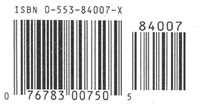
Dimdima
Online Children's Magazine from India

Dimdima
Online Children's Magazine from India

During your visit to a supermarket, you must have observed that the person at the counter uses a simple machine to recognize your purchases. When he runs the machine over the sticker on the product, the computer automatically recognizes the product, and bills you for it. If you have observed the sticker on the product you have purchased, you would have noticed a series of black and white bars. This technology, aptly called “bar code” technology has been in use for the past many years.
What is bar code technology all about? Way back in 1948, the president of a local food chain Company in the US was keen on a system, which could automatically give details of a product. This system, he thought, could help maintain an inventory of the entire stock, and also help identify the goods purchased by a customer.
Bernard Silver, a graduate student at Drexel Institute of Technology in Philadelphia, and his friend Norman Joseph Woodland a teacher at the same Institute set to work on this project. The first idea Woodland thought of was to create a pattern with ultraviolet light sensitive ink. However this was expensive, and the ink was never stable to create the right pattern. Silver and Woodlands modified this technology and patented the first bar code technology. However, their invention was not put to commercial use.
It was in 1966, that bar code technology became universally accepted. Today’s bar code has three major components. A software installed in a computer generates a unique bar code – the black and white lines which actually represent a unique identification tag. This is then printed through a special bar code printer, and pasted on products. A bar code reader “reads” and identifies this unique code and matches it with the details of the product already present in the computer.
Let us take an example of bar code technology in a library. The details of all the books in the library are maintained in the computer, with a unique identification of a bar code for each book. Each member in the library too, gets a unique bar code identification number. When the librarian wants to lend a book, all he or she does is to run the bar code reader on your card that has your unique details, and on the book you wish to take. The computer automatically tags the book to your name and the book is issued to you.
EXPLORE MORE...
Get Help or Give Help.
- Do you have a Science Question?
- Post it here and get the answer.
- Some questions posted by others are not yet answered.
- View those questions and answer them.
Dimdima is the Sanskrit word for ‘drumbeat’. In olden days, victory in battle was heralded by the beat of drums or any important news to be conveyed to the people used to be accompanied with drumbeats.
Bharatiya Vidya Bhavan
K. M Munshi Marg,
Chowpatty, Mumbai - 400 007
email : editor@dimdima.com
Bharatiya Vidya Bhavan
505, Sane Guruji Marg,
Tardeo, Mumbai - 400 034
email : promo@dimdima.com
Dimdima.com, the Children's Website of Bharatiya Vidya Bhavan launched in 2000 and came out with a Printed version of Dimdima Magazine in 2004. At present the Printed Version have more than 35,000 subscribers from India and Abroad.